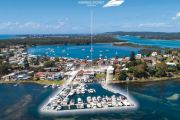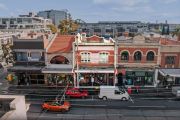
Falls Festival site going for a song as Live Nation cuts asking price
Live Nation Australia has cut the asking price – and added more land – to the site near the Great Ocean Road of the once-iconic Falls Festival, after failing to sell the Lorne property two years ago for $4 million.
The once-blaring main stage still stands, while toilets, shower sites and all-weather outdoor power points dot the 59-hectare site that the local arm of the entertainment giant has put back on sale for $2.5 million – and to which it has added 9.5 hectares in two adjoining lots.

But the musical days of the property on Erskine Falls Road were over and the most likely new purpose of site – a dairy farm before the festival started there in 1993 – would be at the hands of an education or tourism operator, sales agent Jason Hellyer said.
“It’s a beautiful nostalgia story,” Mr Hellyer told The Australian Financial Review on Monday.
“And it truly is magnificent when you walk across the grounds, but who will the buyer be? In my view, it’s an educational group, a camping site group, a glamping group.”
The last Falls Festival – a three-day music event that launched a second location at Marion Bay in Tasmania, and further sites at Byron Bay in NSW and Fremantle in Western Australia – took place in December 2022 at Melbourne’s Sidney Myer Music Bowl and featured artists including American rapper Lil Nas X, Australian rapper Genesis Owusu and The Wiggles.

Live Nation Australia, which took a controlling interest in Falls Festival and Splendour in the Grass operator Secret Sounds Group in 2016, has mothballed its two largest festivals.
It put the Marion Bay site up for sale in 2023 but has not definitively said what will happen to Falls.
Live Nation said it was working to bring back Splendour, a separate music festival in Byron Bay that it cancelled last year shortly after putting tickets for the July event on sale. It won’t return this year either.
“The festivals team has our full support to bring Splendour in the Grass back when they feel it’s right,” a spokeswoman said on Monday.
“In the meantime, we’re working on exciting new projects to support artists and the industry while meeting the demands of music fans, and look forward to sharing more in the coming months.”
Australia’s live music industry is still reeling from the COVID-19 pandemic that shut venues and left many artists in the highly casualised industry ineligible for assistance schemes such as JobKeeper payments.
The value of land previously used for music festivals has also fluctuated widely as a result of borrowing costs and consumer demand.

“What we saw between 2021 and 2023 was a fairly hefty spike in rural values, particularly for lifestyle blocks, because of COVID,” Mr Hellyer said.
“That spike’s pulled back significantly and as a consequence of that the pricing has pulled back significantly.”
In addition to the main stage, the original 59-hectare lot includes a three-bedroom manager’s office, a new 25-metre-by-12-metre concrete-floored shed and office suites as well as the decommissioned festival toilets and power points.
The two lots added to the offering are a 4.3-hectare part-forested, part-cleared Lot 2 and a 5.2-hectare Lot 1. Both were previously used as camping grounds for festival visitors. The lots can be bought in one line or individually under the sale by deadline campaign that ends on March 5.

Music festivals have come under increasing pressure from rising insurance costs, user-pays policing charges, and increasing international artist fees and labour costs, making the low-margin events increasingly unviable, federal government body Creative Australia said last year.
Large commercial festivals – for-profit events for more than 20,000 people – had to presell almost three-quarters (71 per cent) of their tickets to avoid cancellation, but also typically had a shorter period to sell of 7.5 weeks, compared with the average 10 weeks for small commercial festivals and touring festivals, the Soundcheck Two report found.
The average cost of insurance for this-sized festival had soared 173 per cent from $74,273 in 2019 to $202,472 in 2024, the report found.











